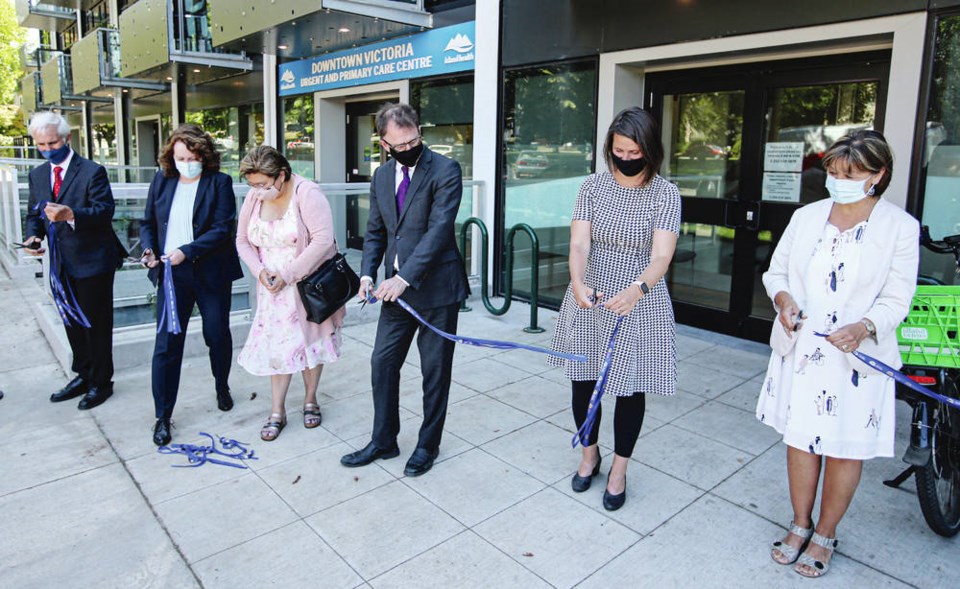The province’s latest urgent and primary care centre — aimed at connecting patients with doctors and easing pressure on emergency rooms — has opened in downtown Victoria, taking over the Integrated Health Centre run by Island Health on Yates Street.
B.C. Health Minister Adrian Dix announced Wednesday the new centre will be located at 1107 Pandora Ave.
It’s the Island’s sixth UPCC. Others have been opened in James Bay, the North Quadra area in Saanich, Esquimalt, the West Shore and Nanaimo.
The Health Ministry says the new UPCC, once fully staffed, will provide ongoing care Monday to Friday from 8 a.m. to 8 p.m., and Saturdays from 8 a.m. to 2 p.m., along with urgent care from 8 a.m. to 8 p.m. seven days a week.
The UPCC will be the largest in the province in terms of physical footprint and include exam rooms, a procedure room, consult rooms, medication rooms, collaborative workspaces and medical office assistant work areas.
Urgent and primary care centres are one of the main components of the province’s efforts to address the ongoing doctor shortage, with 25 such centres opened since the first was established in the West Shore in 2018.
They offer care that’s needed within 12 to 24 hours, aim to connect patients with a primary care provider at the clinic or in the community, and provide a range of practitioners, including a mental-health and addictions component.
They aim to divert non-emergency cases from hospital emergency rooms.
Some doctors say the province should do more to support and expand family practices rather than pumping money into new urgent and primary care centres.
They question whether the UPCC model actually works to attach patients to family doctors, or just drains money and lures staff away from existing clinics.
“I’m very concerned at how many of these UPCCs are now opened in the Greater Victoria area and the negative effects they have on existing private practices and private walk-in clinics,” said Dr. Benjamin How of the Oak Bay Medical Clinic. “I’m concerned that these taxpayer-funded UPCCs are not forced to take on patients on a longitudinal basis but are only operating as walk-in clinics.”
How asked why the government can’t produce numbers for how many patients have been attached to doctors and nurse practitioners at each of the Island’s UPCCs since they first opened.
As well, How said the province’s idea of attaching patients to “clinics” instead of specific physicians or nurse practitioners does not give patients the same quality and consistency of care.
“If a patient has a family doctor and establishes a relationship, they can follow you on a longitudinal basis better than if you are seeing multiple practitioners,” said How.
Dr. Layne Woodburn of the Gordon Head Treatment Centre, a private Saanich primary-care and walk-in clinic that’s on the verge of closing, calls UPCCs more political than practical, and more expensive than established private practices that just need more health-care professionals to share the work.
Dix said in a recent interview that the province’s approach has been successful at adding doctors and nurse practitioners and attaching patients to doctors, and the ministry is preparing data to show those results. “That’s something we’re going to be doing this fall so that people will be able to see and judge against that baseline.”
Some UPCCs on the Island and rest of the province are struggling to attract doctors and are not fully staffed. “It’s a challenge,” Dix conceded.
How maintains the UPCCs are competing with private family practices and walk-in clinics, so existing walk-in clinics can’t staff their practices.
He pointed to the planned closure of the Gordon Head clinic in August as an example of how a long-time existing primary clinic with established patients is folding.
Clinic doctors have said that if they had government support to add needed staff — a nurse or a mental health worker, social worker or physiotherapist, for instance — they could stay open and provide integrated care.



